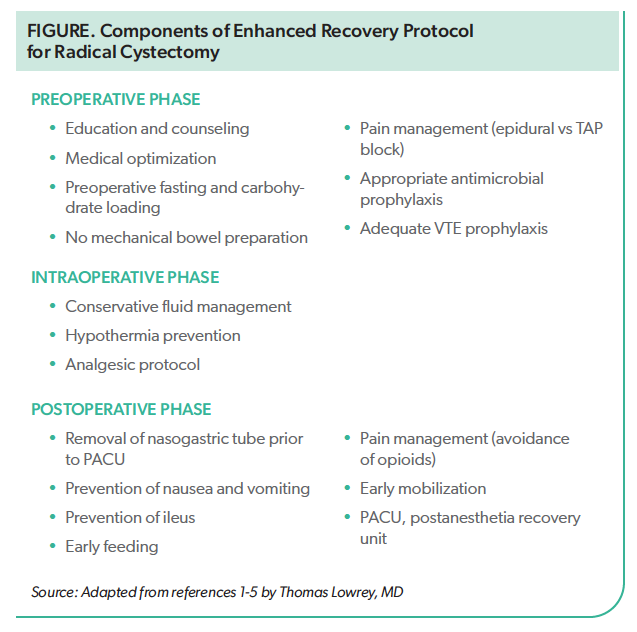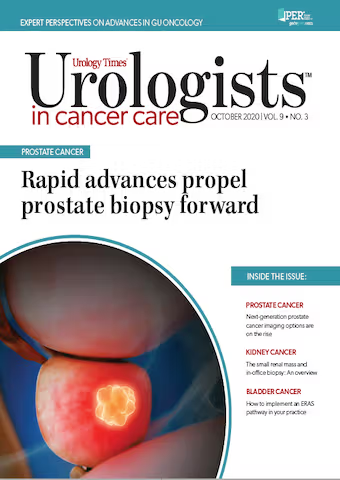Publication
Article
Urology Times Urologists in Cancer Care
How to implement an ERAS pathway in your urology practice
Author(s):
Program encompasses patient counseling, anesthetic planning, and early mobilization.
Enhanced Recovery After Surgery (ERAS) pathways, also known as fast-track protocols, have been adopted since the 1990s by various surgical specialties—including colorectal, vascular, and thoracic surgery—with proven effectiveness. More recently, the protocols have been applied to urologic surgical procedures, most notably radical cystectomy. The goals of such protocols are ultimately to improve patient outcomes, achieve earlier recovery, and reduce cost burdens by focusing on specific preoperative, operative, and postoperative elements.
As we know, radical cystectomy is among the most complex urologic operations, and the patients are often of advanced age with numerous medical comorbidities, making them ideal candidates for structured postoperative pathways to enhance recovery. Although literature regarding ERAS protocols in the setting of radical cystectomy remains limited, studies to date support the protocols’ use to improve morbidity and mortality in these patients. Urologists regularly performing these procedures should consider implementation of a multidisciplinary perioperative care protocol at their institution. This article provides general recommendations and a brief organizational framework to consider if pursuing such endeavors.
Preoperative Considerations
Education and counseling. The first step in implementing successful ERAS protocols is patient counseling. Through face-to-face discussion and standardized patient information packets, the urologist educates the patient before the operation about the surgical procedure; postoperative expectations, including complications; the length of the hospital stay; the stoma site; and the discharge plan.
It is important that the patient’s support system be present for these initial discussions. The urologist should place an early focus on survivorship and provide the patient with information about advocacy networks. Although there is a paucity of literature exploring the importance of education and counseling, cumulative experience supports both.
Medical optimization. Adequate management of medical conditions and lifestyle modifications with nutritional optimization form the outline of the increasingly popular idea of prehabilitation. There have been numerous studies linking preoperative optimization with improved immediate and long-term postoperative outcomes. Optimal management of medical comorbidities, in conjunction with the patient’s primary care physician and specialists when feasible, is important prior to surgery. The urologist should educate the patient before the operation on the importance of smoking cessation and limiting alcohol use as well as stress reduction techniques. The urologist should encourage the patient to increase their exercise to improve mobility and cardiopulmonary reserve, which can be done with the assistance of physical therapists or simply by engaging in 30 minutes of exercise (ie, walking) daily. Preoperative nutritional intervention with the use of immunonutrition containing key amino and fatty acids has been explored in cystectomy literature, but the results have been inconsistent, although its use is supported in other settings and disease processes.1
Preoperative fasting and carbohydrate loading. The urologist should encourage all nondiabetic patients to increase their consumption of carbohydrates before the operation. Solid-food intake is recommended up until 6 hours prior to the induction of general anesthesia, with clear liquids allowed up to 2 hours prior to surgery. Colorectal literature states that this intervention has been shown to improve perioperative insulin-related complications, reduce the length of the hospital stay, and maintain muscle strength.2 It is important to involve anesthesiology colleagues in this aspect of protocol development.

Mechanical bowel preparation. Traditional mechanical bowel preparation can be safely omitted and no longer required. In colorectal surgery, the use of mechanical bowel preparation has been demonstrated to cause dehydration, electrolyte disturbances, and prolonged ileus.1
Pain management. Alternatives for narcotic analgesics have been investigated in surgical literature, with thoracic epidural and transverse abdominus plane (TAP) blocks showing superior pain control over systemic opioids with the additional benefit of less paralytic ileus.3 The urologist should strongly consider the use of either of these techniques during radical cystectomy.
Microbial prophylaxis. Although optimal antimicrobial prophylaxis and duration are still unclear, the urologist’s chosen antibiotic should be effective against both aerobes and anaerobes. The urologist should administer a single dose of antibiotic prior to skin incision within 1 hour before surgery. The urologist should prepare the skin with chlorhexidine-alcohol in standard fashion.
Venous thromboembolism (VTE) prophylaxis. Results of randomized controlled trials demonstrate significant decrease in VTE with the use of a single dose of low-molecular-weight heparin with extended prophylaxis continued for 28 days after the operation.4 This is recommended in combination with sequential compression devices.
Intraoperative Considerations
Fluid management. The restriction of intraoperative fluids combined with preemptive vasopressor use has been shown to significantly reduce postoperative complications and the length of the hospital stay.1 In conjunction with the anesthesiologist, the urologist should administer individual goal-directed fluid therapy with cardiac output monitoring to allow for maintenance of the patient’s fluid requirements in a near-physiologic state. The urologist may also consider the use of transthoracic echocardiogram Doppler-guided fluid therapy.
Hypothermia prevention. Patient warming through the use of warm-air blankets and warmed IV fluids is recommended given that it is associated with a decrease in both surgical site infections and postoperative cardiac complications.
Intraoperative analgesia. It is key for the urologist to develop an anesthetic plan with anesthesiology colleagues to ensure proper anesthetic depth, adequate pain control, and muscle relaxation with the goal of limiting narcotic use and using short acting agents. The urologist should use epidural opioid infusions (ie, hydromorphone) as needed intraoperatively in addition to the standard bupivacaine. The urologist may also consider a ketamine infusion in patients with preoperative chronic pain. In addition, for appropriate patients, the urologist may administer single doses of 1 g IV acetaminophen and 15 mg IV ketorolac at the culmination of the case.
Postoperative Considerations
Nasogastric intubation. The urologist should avoid the use of postoperative nasogastric intubation to shorten time to flatus, limit vomiting, and decrease both wound and pulmonary complications.
Prevention of nausea and vomiting.Unresolved postoperative nausea and vomiting can result in prolonged hospitalizations and an increase in overall cost. These conditions can be minimized with the use of multimodal antiemetic prophylaxis and minimization of opioids.1
Prevention of ileus. The urologist should emphasize epidural anesthesia over intravenous narcotics. The urologist should provide chewing gum to the patient given that it has the demonstrated benefit of stimulating bowel activity. The urologist should prescribe alvimopan for 5 days postoperatively or until the first stool given that it decreases time to bowel function and shortens the length of the hospital stay.5
Early feeding. Early feeding is well tolerated and safe and does not negatively affect overall postoperative outcomes.1 Therefore, the urologist should start oral nutrition on postoperative day zero and advance it as tolerated.
Pain management. As described above, the urologist should use multimodal regimens and avoid long-acting opioids. It is also important to set pain control expectations with the patient. The urologist should schedule adjunctive analgesia with acetaminophen, nonsteroidal anti-inflammatory drugs, and pregabalin/gabapentin when possible along with epidural anesthesia for 2 to 3 days after the operation.
Early mobilization. It is recommended that the urologist set a goal for the patient of 2 hours of ambulatory activity on postoperative day zero and at least 6 hours out of bed per day starting on postoperative day one until discharge to decrease muscle loss, promote insulin sensitivity, improve strength, improve pulmonary function, and decrease risk of VTE. To improve patient motivation, a predetermined daily ambulation plan (ie, distance goals, time-out-of-bed targets) is often helpful. Consultation with inpatient physical and occupational therapy is highly recommended.
Efficacy/Conclusions
Individual components of enhanced recovery pathways remain difficult to evaluate, but there is a large body of evidence reporting numerous measures of improvement for patients treated under such fast-track protocols, including reduced length of hospital stay, fewer wound complications, earlier gastrointestinal recovery, and reductions in readmissions. Ultimately, it is the combined effect of the above elements that leads to positive patient outcomes, not a single “magic bullet.” Therefore, continued protocol refinement and a strong multidisciplinary team commitment are vital for a successful program.
Lowrey is a urology resident at the University of Oklahoma, Shepherd is a urologic oncology fellow at the University of Oklahoma, and Patel is an assistant professor of urology at the University of Oklahoma, Oklahoma City.
References
1. Pozo C, Shariat SF, D’Andrea D, Fajkovic H, Abufaraj M. Enhanced recovery after radical cystectomy. Curr Opin Urol. 2019;29(3):227-238. doi:10.1097/MOU.0000000000000594
2. Nygren J, Thacker J, Carli F, et al. Guidelines for perioperative care in elective rectal/pelvic surgery: Enhanced Recovery After Surgery (ERAS) Society recommendations. Clin Nutr. 2012;31(6):801-816. doi:10.1016/j.clnu.2012.08.012
3. Hughes MJ, Ventham NT, McNally S, Harrison E, Wigmore S. Analgesia after open abdominal surgery in the setting of enhanced recovery surgery: a systematic review and meta-analysis. JAMA Surg. 2014;149(12):1224-1230. doi:10.1001/jamasurg.2014.210
4. Chiang HA, Cheng PJ, Speed JM, et al. Implementation of a perioperative venous thromboembolism prophylaxis program for patients undergoing radical cystectomy on an Enhanced Recovery After Surgery protocol. Eur Urol Focus. 2020;6(1):74-80. doi:10.1016/j.euf.2018.08.025
5. Bazargani ST, Djaladat H, Ahmadi H, et al. Gastrointestinal complications following radical cystectomy using enhanced recovery protocol. Eur Urol Focus. 2018;4(6):889-894. doi:10.1016/j.euf.2017.04.003
Newsletter
Stay current with the latest urology news and practice-changing insights — sign up now for the essential updates every urologist needs.


















